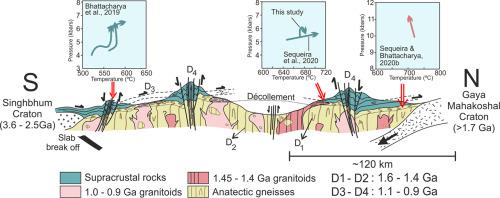Geoscience Frontiers ( IF 8.5 ) Pub Date : 2021-01-06 , DOI: 10.1016/j.gsf.2020.12.017 Nicole Sequiera , Abhijit Bhattacharya , Elizabeth Bell

|
In paleogeographic reconstructions of Columbia and Rodinia Supercontinents, the position of the Greater India landmass is ambiguous. This, coupled with a limited understanding of the tectonic evolution of the mobile belts along which the mosaic of crustal domains in India accreted, impedes precise correlation among the dispersed crustal fragments in supercontinent reconstructions. Using structural, metamorphic phase equilibria, chronological and geochemical investigations, this study aims to reconstruct the tectonic evolution of the Chottanagpur Gneiss Complex (CGC) as a distinct crustal block at the eastern end of the Greater Indian Proterozoic Fold Belt (GIPFOB) along which the North India Block (NIB) and the South India Block (SIB) accreted. The study focuses on two issues, e.g. dating the Early Neoproterozoic (0.92 Ga) accretion of the CGC with the NIB contemporaneous with the assembly of Rodinia, and documenting the widespread (>24,000 km2) plutonism of 1.5–1.4 Ga weakly peraluminous, calc-alkalic to alkali-calcic and ferroan A-type granitoids (± garnet) devoid of mafic microgrannular enclaves and coeval mafic emplacements in the crustal block. These dominantly within-plate granitoids arguably formed by asthenospheric upwelling induced partial melting of garnet-bearing anatectic quartzofeldspathic gneisses that constitute the Early Mesoproterozoic basement of the block. The major and trace element chemistry of the granitoids is similar to the 1.35–1.45 Ga A-type granitoids in Laurentia/Amazonia emplaced contemporaneous with the 1.5–1.3 Ga breakup of the Columbia Supercontinent.
This study suggests the Chottanagpur Gneiss Complex is a crustal block fragmented following the breakup of the Columbia Supercontinent; the crustal block was subsequently integrated within India during the Early Neoproterozoic oblique accretion between the NIB and SIB contemporaneous with the Rodinia Supercontinent assembly.
中文翻译:

印度“乔塔纳格普尔地壳”中的〜1.4 Ga A型花岗石及其从哥伦比亚迁移到罗迪尼亚?
在哥伦比亚和罗迪尼亚超大陆的古地理重建中,大印度大陆的位置是模棱两可的。加上对流动带构造演化的有限了解,印度地壳区域的镶嵌物沿这些带演化,这阻碍了超大陆重建中分散的地壳碎片之间的精确关联。利用结构,变质相平衡,年代学和地球化学研究,本研究旨在将乔塔纳格普尔片麻岩复合体(CGC)的构造演化重构为大印度元古代褶皱带(GIPFOB)东端的独特地壳块。北印度区(NIB)和南印度区(SIB)增值。该研究集中在两个问题上,例如约会新元古代早期(0。2)1.5至1.4 Ga弱岩性,钙铁性弱,钙质至碱性,铁质A型花岗岩(±石榴石),缺少镁铁质微粒状飞地和地壳中的黑质镁铁质。这些主要的板内花岗岩可能是由软流圈上升引起的,带有石榴石的含铅的高铁石英斜长片麻岩的部分熔融形成的,构成了该块的早中古生代基底。花岗岩的主要和微量元素化学性质与Laurentia / Amazonia中的1.35–1.45 Ga A型花岗岩相似,与哥伦比亚超大陆的1.5–1.3 Ga破裂同时发生。
这项研究表明,霍塔纳格普尔片麻岩复合体是哥伦比亚超大陆破裂后破碎的地壳块。随后,在与Rodinia Supercontinent组件同时进行的NIB和SIB之间的新元古代早期斜生过程中,地壳块随后整合到印度。











































 京公网安备 11010802027423号
京公网安备 11010802027423号